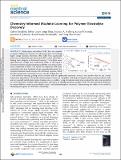Chemistry-Informed Machine Learning for Polymer Electrolyte Discovery
Author(s)
Bradford, Gabriel; Lopez, Jeffrey; Ruza, Jurgis; Stolberg, Michael A.; Osterude, Richard; Johnson, Jeremiah A.; Gomez-Bombarelli, Rafael; Shao-Horn, Yang; ... Show more Show less
DownloadPublished version (3.554Mb)
Publisher with Creative Commons License
Publisher with Creative Commons License
Creative Commons Attribution
Terms of use
Metadata
Show full item recordAbstract
Solid polymer electrolytes (SPEs) have the potential to improve lithium-ion batteries by enhancing safety and enabling higher energy densities. However, SPEs suffer from significantly lower ionic conductivity than liquid and solid ceramic electrolytes, limiting their adoption in functional batteries. To facilitate more rapid discovery of high ionic conductivity SPEs, we developed a chemistry-informed machine learning model that accurately predicts ionic conductivity of SPEs. The model was trained on SPE ionic conductivity data from hundreds of experimental publications. Our chemistry-informed model encodes the Arrhenius equation, which describes temperature activated processes, into the readout layer of a state-of-the-art message passing neural network and has significantly improved accuracy over models that do not encode temperature dependence. Chemically informed readout layers are compatible with deep learning for other property prediction tasks and are especially useful where limited training data are available. Using the trained model, ionic conductivity values were predicted for several thousand candidate SPE formulations, allowing us to identify promising candidate SPEs. We also generated predictions for several different anions in poly(ethylene oxide) and poly(trimethylene carbonate), demonstrating the utility of our model in identifying descriptors for SPE ionic conductivity.
Date issued
2023-01-23Department
Massachusetts Institute of Technology. Department of Materials Science and Engineering; Massachusetts Institute of Technology. Department of Mechanical Engineering; Massachusetts Institute of Technology. Research Laboratory of Electronics; Massachusetts Institute of Technology. Department of ChemistryJournal
ACS Central Science
Publisher
American Chemical Society
Citation
Gabriel Bradford, Jeffrey Lopez, Jurgis Ruza, Michael A. Stolberg, Richard Osterude, Jeremiah A. Johnson, Rafael Gomez-Bombarelli, and Yang Shao-Horn ACS Central Science 2023 9 (2), 206-216.
Version: Final published version
ISSN
2374-7943
2374-7951